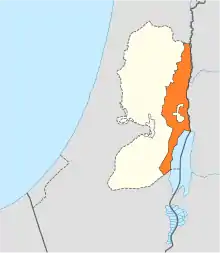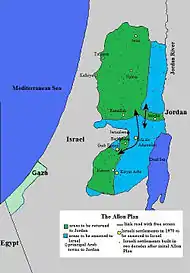ضم غور الأردن
ضم غور الأردن هو تطبيق للمقترح الإسرائيلي بفرض السيادة الإسرائيلية على غور الأردن. دعا بعض السياسيين الإسرائيليين إلى هذه الفكرة منذ بدء الاحتلال الإسرائيلي للضفة الغربية في عام 1967، وكان أبرزها ضمن خطة آلون عام 1967 وخطة نتنياهو عام 2019.


غور الأردن
بحسب منظمة بتسيلم، يعيش في المنطقة نحو 65,000 فلسطيني وحوالي 11,000 مستوطن إسرائيلي.[1][2] وفقًا لـمنظمة السلام الآن، يشمل الاقتراح 30 مستوطنة مع 12,778 مستوطنًا إسرائيليًا، و 18 بؤرة استيطانية إسرائيلية غير قانونية، و15 منطقة تقع ضمن تصنيفي أ وب، يسكنها نحو 44,175 فلسطينيًا و 48 مضربًا للبدو في المنطقة ج يسكنها نحو 8,775 فلسطينيًا.[3] تبلغ المساحة المراد ضمها حوالي 22% من الضفة الغربية، تشكل المنطقة "ج" منها نحو 90% و20% من الأراضي مملوكة ملكية خاصة لفلسطينيين.
مقترحات
 مقالة مفصلة: مقترحات ضم إسرائيل للضفة الغربية
مقالة مفصلة: مقترحات ضم إسرائيل للضفة الغربية
خطة آلون
 مقالة مفصلة: خطة آلون
مقالة مفصلة: خطة آلون
بعد فترة وجيزة من حرب 1967، صاغ الوزير الإسرائيلي إيغال آلون خط سميت باسمه "خطة آلون" لتقسيم الضفة الغربية بين إسرائيل والمملكة الأردنية الهاشمية، إقامة دولة درزية في هضبة الجولان الواقعة تحت الاحتلال الإسرائيلي، وإعادة غالبية شبه جزيرة سيناء إلى السيطرة العربية. كان الهدف العام للخطة هو ضم معظم غور الأردن من النهر إلى المنحدرات الشرقية لحافة تلال الضفة الغربية، والقدس الشرقية وجوش عتصيون إلى إسرائيل. بينما الأجزاء المتبقية من الضفة الغربية، والتي يقطن فيها غالبية السكان الفلسطينيين، كانت ستصبح تحت الحكم الذاتي الفلسطيني، أو ستعود إلى الأردن، بما في ذلك ممر إلى الأردن من خلال أريحا. رفض الملك الأردني الحسين بن طلال الخطة. وتوفي آلون في عام 1980، وفي السنة التالية صادقت الحكومة الإسرائيلية على قانون مرتفعات الجولان، لتضم فعليًا إلى إسرائيل.[4][5][6]
خطة نتانياهو
في 10 سبتمبر 2019، وقبل أسبوع من الانتخابات التشريعية الإسرائيلية في سبتمبر 2019، أعلن نتنياهو عن خطة حكومته لضم غور الأردن، وسيطبقها إذا فاز في الانتخابات. الخريطة التي عرضها نتنياهو للمنطقة التي سيتم ضمها، فيها العديد من الأخطاء، خصوصًا موقع العديد من المستوطنات الإسرائيلية وحذف القرى الفلسطينية.[7][8] ذكر نتنياهو إنه تلقى ضوءًا أخضر من إدارة دونالد ترامب الأمريكية، والتي قالت إنه لم يكن هناك أي تغيير في سياسة الولايات المتحدة.[9][10]
في اليوم التالي، كانت هناك إدانة دولية للاقتراح من الفلسطينيين وجامعة الدول العربية والسعودية والأردن وتركيا والمملكة المتحدة والأمم المتحدة. كما قالت الأمم المتحدة:".. أن أي خطوة إسرائيلية لفرض سيادتها على الأراضي الفلسطينية من شأنه أن تكون غير قانونية بموجب القانون الدولي".[11] وصف العديد من السياسيين الإسرائيليين من مختلف الأطياف السياسية ووسائل الإعلام العبرية هذا الإعلان بأنه حيلة سياسية للتصويت. كان أبرزهم موشيه يعلون، عضو الكنيست من ائتلاف أزرق أبيض، الذي قال: أن نتنياهو وافق عام 2014 مبدئيًا على إخلاء مستوطنات غور الأردن. في عام 2014، كان يعلون عضوًا في حزب الليكود، وعمل تحت قيادة نتنياهو وزيرًا للدفاع.[12]
أعلن بنيامين نتانياهو في 13 أغسطس 2020 بأنه يُوافق على تعليق خطة الضم بعد توقيع معاهدة السلام الإماراتية الإسرائيلية، والتي حصلت بوساطة أمريكية.
المراجع
- "The Jordan Valley". B'Tselem. 2017-11-17. مؤرشف من الأصل في 22 أبريل 2020. اطلع عليه بتاريخ 15 سبتمبر 2019. الوسيط
|CitationClass=تم تجاهله (مساعدة) - "Netanyahu announces post-election plan to annex Jordan Valley". Aljazeera. 11 September 2019. مؤرشف من الأصل في 09 يناير 2020. اطلع عليه بتاريخ 11 سبتمبر 2019. الوسيط
|CitationClass=تم تجاهله (مساعدة) - "Data on Netanyahu's Jordan Valley Annexation Map". PeaceNow. 2019-09-11. مؤرشف من الأصل في 02 فبراير 2020. اطلع عليه بتاريخ 15 سبتمبر 2019. الوسيط
|CitationClass=تم تجاهله (مساعدة) - Avi Shlaim, 2001, The Iron Wall: "Victory in the Six-Day War marked the beginning of a new era in Israel's history – an era of uncertainty. The victory reopened the old question about the territorial aims of Zionism...The question was what to do with these territories, and to this question there was no simple answer... On 26 July he [Allon] submitted to the cabinet a plan that was to bear his name [The Allon Plan]. It called for incorporating in Israel the following areas: a strip of land ten to fifteen kilometers wide along the Jordan River; most of the Judean desert along the Dead Sea; and a substantial area around Greater Jerusalem, including the Latrun salient. Designed to include as few Arabs as possible in the area claimed for Israel, the plan envisaged building permanent settlements and army bases in these areas. Finally, it called for opening negotiations with local leaders on turning the remaining parts of the West Bank into an autonomous region that would be economically linked to Israel. The cabinet discussed Allon's plan but neither adopted nor rejected it."
- Kenneth W. Stein, 1999, Heroic Diplomacy: Sadat, Kissinger, Carter, Begin and the Quest for Arab-Israeli Peace: "Submitted to several Israeli Cabinets for approval but not officially endorsed, the Allon Plan was initially presented in July 1967. The plan’s core assumptions included defensible borders as defined by Israel, a return of the densely populated areas to a 'Jordanian-Palestinian state' with Israel retaining control of the Jordan Rift Valley and mountain ridges to the west from Nablus to Hebron. Under the plan, Israel would assert and sustain military presence over the West Bank up to the Jordan River, the West Bank would be demilitarized, the Palestinians would be provided self-administration in an autonomous or semiautonomous region, and Israel would remain in full control over a united Jerusalem, with perhaps a Jordanian status in the Muslim quarter of the Old City. Israeli leaders then ruled out the possibility of incorporating the West Bank Palestinian population into a greater Israel because it would have dramatically changed the states Jewish demographic orientation. When the Allon Plan was officially offered to the king [of Jordan] in cordial and secret talks in September 1968, Hussein rejected it because he felt it 'infringed on Jordanian sovereignty.' Nonetheless, the Allon Plan served as a basis for the Labor Party election platforms in 1974, 1977, 1981, 1984, and 1987. The concept of providing autonomy or self-administration for the Palestinians was offered by Israeli Prime Minister Begin to Sadat in December 1977 and enshrined in both the September 1978 Camp David and the September 1993 Oslo Accords."
- Yehudit Auerbach, 1991, Journal of Conflict Resolution, "Attitudes to an Existence Conflict: Allon and Peres on the Palestinian Issue, 1967–1987": "The [Allon] plan called for a political settlement of the conflict between Israel and the Arab states, based on the following themes: Israel would not return to the June 4, 1967 borders; the Jordan River would be Israel's defense border; Jerusalem, the capital of Israel, would remain united; and a solution to the Palestinian problem would be found as part of a peace agreement with Jordan. This plan was never officially adopted by Israel's government, although it has never been rejected either. Moreover, it shaped, to a great extent, Israel's settlement policy in the West Bank and Gaza during the years from 1967 to 1977."
- Daraghmeh, Mohammed; Heller, Aron (11 September 2019). "A look at the Jordan Valley Israeli PM has vowed to annex". أسوشيتد برس. مؤرشف من الأصل في 02 فبراير 2020. اطلع عليه بتاريخ 14 سبتمبر 2019. الوسيط
|CitationClass=تم تجاهله (مساعدة) - Magid, Jacob (12 September 2019). "PM's Jordan Valley map was error-strewn, but is his vow worth taking seriously?". Times of Israel. مؤرشف من الأصل في 02 فبراير 2020. اطلع عليه بتاريخ 14 سبتمبر 2019. الوسيط
|CitationClass=تم تجاهله (مساعدة) - "Netanyahu vows to annex all settlements, starting with Jordan Valley". The Jerusalem Post. مؤرشف من الأصل في 28 مارس 2020. الوسيط
|CitationClass=تم تجاهله (مساعدة) - Smith, Saphora; Goldman, Paul (11 September 2019). "Netanyahu seeks to annex West Bank 'in coordination' with U.S." NBC News. مؤرشف من الأصل في 07 أبريل 2020. الوسيط
|CitationClass=تم تجاهله (مساعدة) - "'Devastating': Global condemnation after Netanyahu pledges to annex Jordan Valley, in occupied West Bank". Independent. 11 September 2019. مؤرشف من الأصل في 18 أبريل 2020. اطلع عليه بتاريخ 11 سبتمبر 2019. الوسيط
|CitationClass=تم تجاهله (مساعدة) - "Netanyahu's Jordan Valley sovereignty vow widely panned by politicians as 'spin'". تايمز إسرائيل. 11 September 2019. مؤرشف من الأصل في 2 فبراير 2020. اطلع عليه بتاريخ 11 سبتمبر 2019. الوسيط
|CitationClass=تم تجاهله (مساعدة)
- بوابة إسرائيل
- بوابة فلسطين
- بوابة الصراع العربي الإسرائيلي
